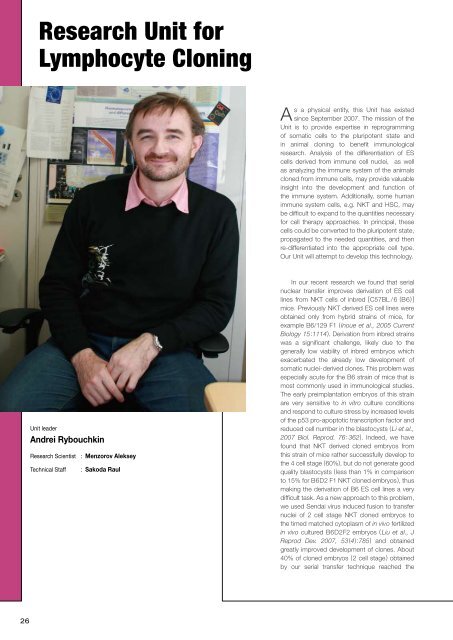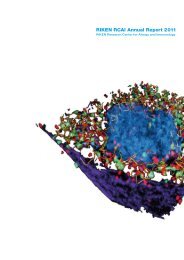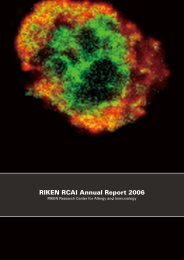in vivo
in vivo
in vivo
Create successful ePaper yourself
Turn your PDF publications into a flip-book with our unique Google optimized e-Paper software.
Research Unit for<br />
Lymphocyte Clon<strong>in</strong>g<br />
As a physical entity, this Unit has existed<br />
s<strong>in</strong>ce September 2007. The mission of the<br />
Unit is to provide expertise <strong>in</strong> reprogramm<strong>in</strong>g<br />
of somatic cells to the pluripotent state and<br />
<strong>in</strong> animal clon<strong>in</strong>g to benefit immunological<br />
research. Analysis of the differentiation of ES<br />
cells derived from immune cell nuclei, as well<br />
as analyz<strong>in</strong>g the immune system of the animals<br />
cloned from immune cells, may provide valuable<br />
<strong>in</strong>sight <strong>in</strong>to the development and function of<br />
the immune system. Additionally, some human<br />
immune system cells, e.g. NKT and HSC, may<br />
be difficult to expand to the quantities necessary<br />
for cell therapy approaches. In pr<strong>in</strong>cipal, these<br />
cells could be converted to the pluripotent state,<br />
propagated to the needed quantities, and then<br />
re-differentiated <strong>in</strong>to the appropriate cell type.<br />
Our Unit will attempt to develop this technology.<br />
Unit leader<br />
Andrei Rybouchk<strong>in</strong><br />
Research Scientist : Menzorov Aleksey<br />
Technical Staff<br />
: Sakoda Raul<br />
In our recent research we found that serial<br />
nuclear transfer improves derivation of ES cell<br />
l<strong>in</strong>es from NKT cells of <strong>in</strong>bred [C57BL /6 (B6)]<br />
mice. Previously NKT derived ES cell l<strong>in</strong>es were<br />
obta<strong>in</strong>ed only from hybrid stra<strong>in</strong>s of mice, for<br />
example B6/129 F1 (Inoue et al., 2005 Current<br />
Biology 15:1114). Derivation from <strong>in</strong>bred stra<strong>in</strong>s<br />
was a significant challenge, likely due to the<br />
generally low viability of <strong>in</strong>bred embryos which<br />
exacerbated the already low development of<br />
somatic nuclei-derived clones. This problem was<br />
especially acute for the B6 stra<strong>in</strong> of mice that is<br />
most commonly used <strong>in</strong> immunological studies.<br />
The early preimplantation embryos of this stra<strong>in</strong><br />
are very sensitive to <strong>in</strong> vitro culture conditions<br />
and respond to culture stress by <strong>in</strong>creased levels<br />
of the p53 pro-apoptotic transcription factor and<br />
reduced cell number <strong>in</strong> the blastocysts (Li et al.,<br />
2007 Biol. Reprod. 76: 362). Indeed, we have<br />
found that NKT derived cloned embryos from<br />
this stra<strong>in</strong> of mice rather successfully develop to<br />
the 4 cell stage (60%), but do not generate good<br />
quality blastocysts (less than 1% <strong>in</strong> comparison<br />
to 15% for B6D2 F1 NKT cloned embryos), thus<br />
mak<strong>in</strong>g the derivation of B6 ES cell l<strong>in</strong>es a very<br />
difficult task. As a new approach to this problem,<br />
we used Sendai virus <strong>in</strong>duced fusion to transfer<br />
nuclei of 2 cell stage NKT cloned embryos to<br />
the timed matched cytoplasm of <strong>in</strong> <strong>vivo</strong> fertilized<br />
<strong>in</strong> <strong>vivo</strong> cultured B6D2F2 embryos ( Liu et al., J<br />
Reprod Dev. 2007, 53(4):785) and obta<strong>in</strong>ed<br />
greatly improved development of clones. About<br />
40% of cloned embryos (2 cell stage) obta<strong>in</strong>ed<br />
by our serial transfer technique reached the<br />
26





